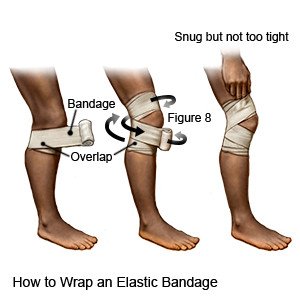Sprain
Medically reviewed by Drugs.com. Last updated on Aug 4, 2025.
A sprain is a stretched or torn ligament. Ligaments support your joints and keep your bones in place. They allow you to lift, lower, or rotate your arms and legs. A sprain may involve one or more ligaments.
DISCHARGE INSTRUCTIONS:
Return to the emergency department if:
- You have numbness or tingling below the injury, such as in your fingers or toes.
- The skin over your sprained area is blue or pale.
- Your pain has increased or returned, even after you take pain medicine.
Call your doctor if:
- Your symptoms do not better.
- Your swelling has increased or returned.
- Your joint becomes more weak or unstable.
- You have questions or concerns about your condition or care.
Medicines:
You may need any of the following:
- Prescription pain medicine may be given. Ask your healthcare provider how to take this medicine safely. Some prescription pain medicines contain acetaminophen. Do not take other medicines that contain acetaminophen without talking to your healthcare provider. Too much acetaminophen may cause liver damage. Prescription pain medicine may cause constipation. Ask your healthcare provider how to prevent or treat constipation.
- Acetaminophen decreases pain and fever. It is available without a doctor's order. Ask how much to take and how often to take it. Follow directions. Read the labels of all other medicines you are using to see if they also contain acetaminophen, or ask your doctor or pharmacist. Acetaminophen can cause liver damage if not taken correctly.
- NSAIDs , such as ibuprofen, help decrease swelling, pain, and fever. This medicine is available with or without a doctor's order. NSAIDs can cause stomach bleeding or kidney problems in certain people. If you take blood thinner medicine, always ask your healthcare provider if NSAIDs are safe for you. Always read the medicine label and follow directions.
- Take your medicine as directed. Contact your healthcare provider if you think your medicine is not helping or if you have side effects. Tell your provider if you are allergic to any medicine. Keep a list of the medicines, vitamins, and herbs you take. Include the amounts, and when and why you take them. Bring the list or the pill bottles to follow-up visits. Carry your medicine list with you in case of an emergency.
A support device
such as an elastic bandage, splint, brace, or cast may be needed. These devices limit movement and protect the joint. You may need to use crutches if the sprain is in your leg. This will help decrease your pain as you move around.
Self-care:
- Rest your joint so that it can heal. Return to normal activities as directed.
- Apply ice on your injury for 15 to 20 minutes every hour or as directed. Use an ice pack, or put crushed ice in a plastic bag. Cover the bag with a towel before you apply it. Ice helps prevent tissue damage and decreases swelling and pain.
- Compress the injured area as directed. Ask your healthcare provider if you should wrap an elastic bandage around your injured ligament. An elastic bandage provides support and helps decrease swelling and movement so your joint can heal.

- Elevate the injured area above the level of your heart as often as you can. This will help decrease swelling and pain. Prop the injured area on pillows or blankets to keep it elevated comfortably.
Physical therapy:
A physical therapist teaches you exercises to help improve movement and strength, and to decrease pain.
Prevent another sprain:
Regular exercise can strengthen your muscles and help prevent another injury. Do the following before you begin or return to regular exercise or sports training:
- Ask your healthcare provider about the activities you can do. Find out how long your ligament needs to heal. Do not do any physical activity until your healthcare provider says it is okay. If you start activity too soon, you may develop a more serious injury.
- Warm up and cool down when you exercise. Run in place slowly or walk at a brisk pace to warm your muscles before you exercise. When you finish exercising, walk for a few minutes to cool down.

- Go slowly. Slowly increase how often and how long you exercise or train. Sudden increases in how often you train may cause you to overstretch or tear your ligament.
- Use the right equipment. Always wear shoes that fit well and are made for the activity that you are doing. You may also use ankle supports, elbow and knee pads, or braces.
Follow up with your doctor as directed:
Write down your questions so you remember to ask them during your visits.
© Copyright Merative 2025 Information is for End User's use only and may not be sold, redistributed or otherwise used for commercial purposes.
The above information is an educational aid only. It is not intended as medical advice for individual conditions or treatments. Talk to your doctor, nurse or pharmacist before following any medical regimen to see if it is safe and effective for you.
Learn more about Sprain
Care guides
Further information
Always consult your healthcare provider to ensure the information displayed on this page applies to your personal circumstances.
